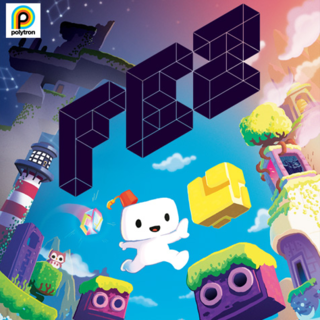INTRO:
That there are aspiring game-makers is a fact. That only a few of them would become wildly successful while the rest fades into obscurity or even ignominy is also a fact.
Fez’s and Polytron’s fortune would be a fact which sits somewhere in between these two outcomes, not only because of Phil Fish’s rash decisions, but also because of some of Fez’s setbacks as a game.
The game, which originated on the Xbox 360 platform, is praised for having clever puzzles which make use of its peculiar view-rotating mechanism. However, it is not the most well-optimized of games, and some of its ambition is marred by less than satisfying rewards for overcoming its considerable challenges.
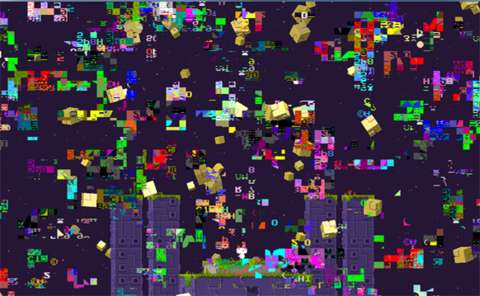
PREMISE:
Fez starts itself off with a story-telling trope which is not rare in video games. The silent protagonist, whom the player would know is called “Gomez” later, wakes up in his small single-room house to one day which will forever change his idyllic life.
Gomez is a member of a vaguely humanoid race of white-colored creatures, who may themselves be homage to old computer games of yore where humans are represented with vaguely humanoid clusters of pixels. He lives in a horizontally-challenged village with a curiously small population, but which is otherwise peaceful.
However, the village has a tradition of sending one of its own to claim the titular headwear. Gomez is the next in line for this, with no reason other than just ‘cos.
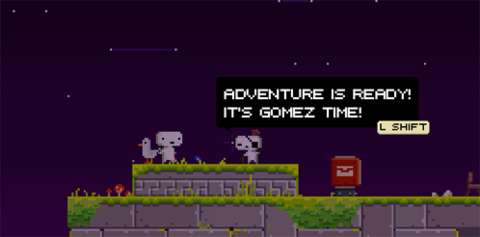
Of course, Gomez’s adventure goes awry almost from the get-go, if the first screenshot in this review does not suggest so already.
LESS-THAN-CONVENTIONAL SAVE-GAME SYSTEM:
Even during the days of the original Xbox LIVE version of Fez, Polytron’s inexperience was already apparent from the game’s many technical issues. One year on, their inexperience has carried over to the computer version of the game as well. This much is apparent when the player figures out how to work with the game’s progress-recording system.
Firstly, there are only three save-game files available for use. This would raise the ire of computer-centric players who have been expecting more versatility. They would be even more incensed to know that the game uses an auto-save feature.
At the very least, the player can copy an existing save-game file into another in order to create a backup. However, there being only three slots, the player should not expect to be able to create and maintain multiple parallel play-throughs.
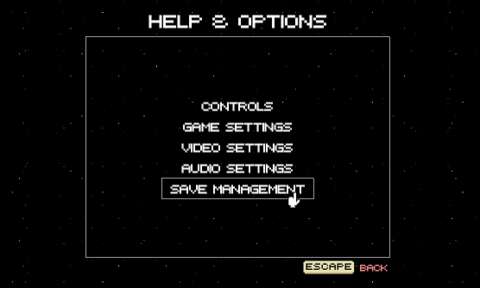
CONTROLS:
To a computer-centric player, the controls for the computer version of Fez can seem odd and inconvenient. To cite an example, the “Enter” key is used to access the main menu, instead of the usual “Esc” key.
There are other signs that Polytron has not optimized the game for the computer platform. The mouse can be used to look around, but the camera keeps snapping back to its default position. In contrast, the keyboard counterparts, which is the “IJKL” set of keys, do not have this snap-back issue, but are understandably less suitable for this purpose.
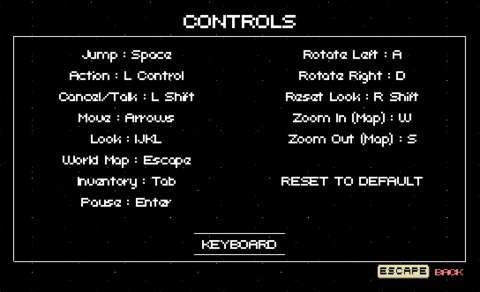
Assuming that the player has the patience to acclimatize himself/herself to the controls, he/she would find that they are just adequate to play the game with. Yet, there is still the impression that optimizing the game for the computer platform is not high on Polytron’s list of priorities.
TUTORIALS:
At least there are tutorials which ease the player into the use of the controls. These generally occur at the first few “zones” which Gomez goes to. In his home village, text prompts appear close to his sprite, or above his head, telling the player what to do to progress.
Similarly, whenever the player comes across something new in the other zones, there are short instructions for that too.
After these tutorials, however, the player is left to his/her own devices.
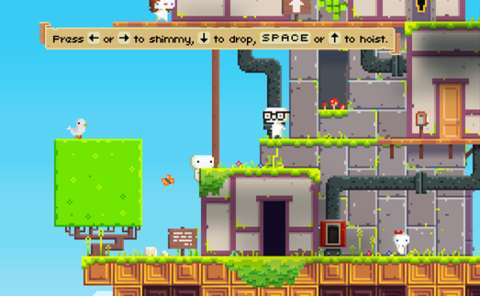
FALLING:
Very, very early on in the game, the careless player is shown what happens if he/she somehow has Gomez falling from up high and landing a considerable vertical distance away.
He dies, unsurprisingly. However, it has to be said here that most 2-D platforming games waive the deadly effects of gravity; Fez does not.
Yet, Fez is not exactly unforgiving. Shortly after Gomez falls to his death, he returns to the platform where he was before he fell, as if the mishap has not happened at all.
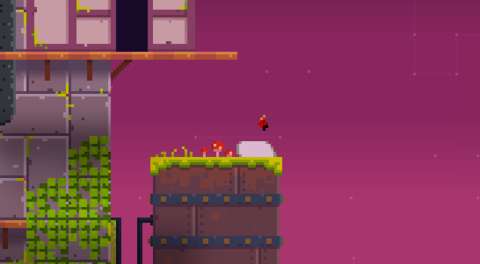
DOT THE COMPANION:
Soon after things have gone wrong in the prologue, Gomez is joined by a floating kaleidoscopic companion which calls itself “Dot”.
Dot is not a very interesting character, and neither is it a particularly entertaining companion. It may make some references to Zelda here and there. At other times, it utters gibberish or makes seemingly irrelevant remarks with significance which is only clear in hindsight.
However, Dot does have some more practical designs. For the first few zones, Dot acts as a tutorial instructor. It also appears next to objects of interest, practically highlighting them and bringing them to the player’s attention.
One of Dot’s more useful capabilities is that it expands and shows a view of the locale which is associated with an exit from the current stage. This view is usually enough to give the player an idea of where he/she is going.
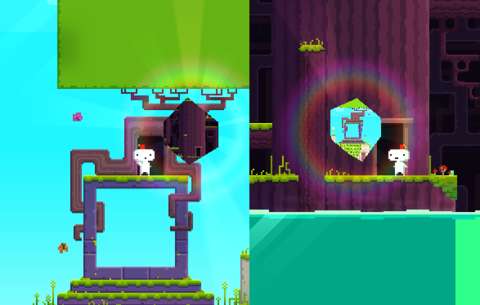
However, these views are only provided after the player has visited the locales shown.
ROTATING THE WORLD:
Despite looking all 2-D, the stages seen in Fez are actually composed of 3-D models with only one of their four facings visible on-screen at any one time. The player can see the other faces of these 3-D models by rotating the game world, which is an action that can be performed after Gomez has obtained the Fez. Even for jaded players, this can seem rather refreshing.
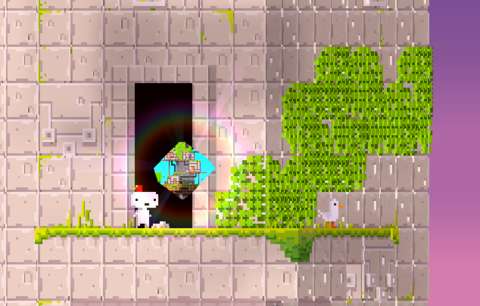
2-D PLANES FROM 3-D MODELS:
Fez is a 2-D platformer; there is no changing that fact. However, Fez has a peculiar take on the mechanism for 2-D planes.
One could argue that this take has been done by other, earlier games. To be specific, this method makes use of the player’s perspective to create 2-D planes out of objects, the locations of which changes according to the player’s perspective.
Yet, those other games merely made use of parallax views. Fez’s method, on the other hand, makes use of orthographic projections of 3-D models.
As an elaborative example of the consequences of this difference, the length of a floating platform is the space which Gomez gets to stand on in the default view. After the player has rotated the world, the width of the floating platform becomes the space which he can stand on instead.
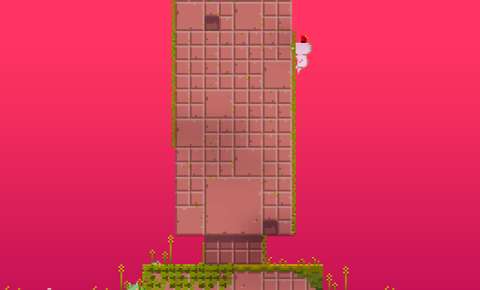
GOMEZ’S POSITION WHEN ROTATING WORLDS:
Although the player can rotate the world at will, Gomez’s on-screen position is not changed by much at all. He will stand where he was on, even if the platform which he was standing on is being rotated too.
This can result in Gomez actually falling off the platform if it has been rotated to its narrow side. In the case that Gomez falls and face-plants from this unwitting mishap, the game re-rotates the world back to the previous view before respawning Gomez.
Despite this risk though, the player must learn to use this peculiarity to reveal a sequence of platforms which Gomez can reach.
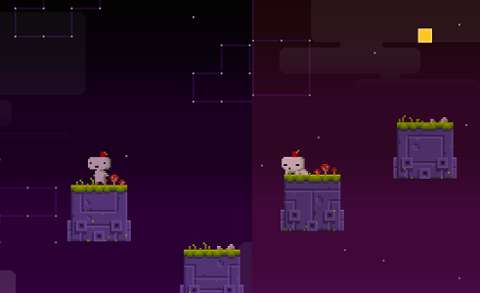
Gomez’s momentum from a jump is not maintained after the world has been rotated. This is a lost opportunity to allow the player some physics shenanigans.
CUBES & ANTI-CUBES:
The main goal of the gameplay in Fez is to collect floating objects which are called “cubes”. They stand out from the 2-D environment because they happen to exhibit their 3-D qualities.
Regular (yellow-colored) cubes are generally obtained by collecting what Gomez’s companion, Dot, calls “bits”. These are smaller (yellow-colored) cubes.
Bits happen to flash periodically, emitting a chime each time. This makes them easier to notice when they are visually obscured. When eight bits are collected (the amount itself being a reference to the architecture of old games of yore), they are gathered together into a regular cube.
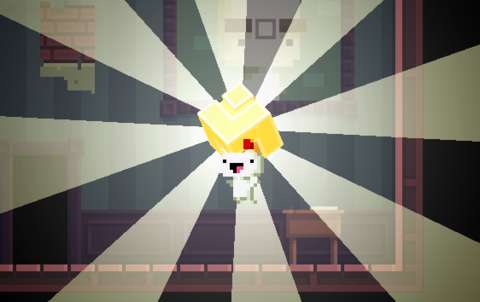
There are rare occasions when the player can retrieve an entire regular cube. Oddly though, regular cubes do not appear to flash or emit chimes.
Despite the drivel which Dot spews when describing them, ‘anti-cubes’ are practically regular cubes which are less straight-forward to find.
To elaborate, regular cubes are often found through mere platforming and exploration, but getting anti-cubes is a far different matter. This will be elaborated later, because it concerns a part of the gameplay which is hardly about 2-D platforming.
In any case, the player will need both regular and anti-cubes to progress in the game.
PLATFORMING HAZARDS:
True to the genre which it belongs, Fez has a lot of hazards which hamper the player’s attempts at platforming. One of these hazards is associated with the story and is more common than the rest – annoyingly so. It will be elaborated further later.
The more familiar hazards include fall from great heights, which have been mentioned earlier. Thanks to the aforementioned respawning mechanism, this kind of hazard is not too frustrating.
Then there are temporary platforms, which only appear for a while for Gomez to stand on.
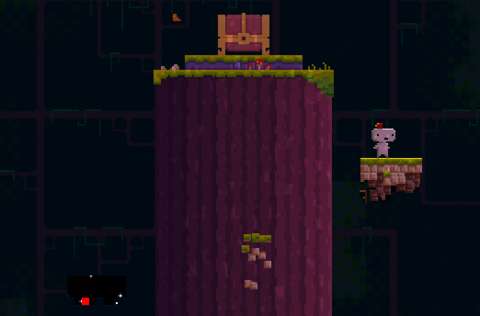
There are other hazards, such as rotating platforms which cause the world to be rotated too if Gomez is standing on them. There are also blocks which attempt to crush Gomez against other blocks; amusingly, the player can rotate the world to prevent this from happening while giving Gomez a boost upwards.
The player only needs observation to learn the patterns of these hazards. However, if the player has completed at least one playthrough, one of the abilities which Fez gains makes some, if not most, of these hazards all but trivial.
WATER:
There are zones where there are significant bodies of water, usually at the bottom. At certain times, the player will need to have Gomez swim some distance to reach a ledge which cannot be reached with running jumps.
Yet, there are not a lot of puzzles in the game which utilize water. There are a couple of secrets about bodies of water which are interesting, but other than acting as restrictions on where the player may go, there is not much else.
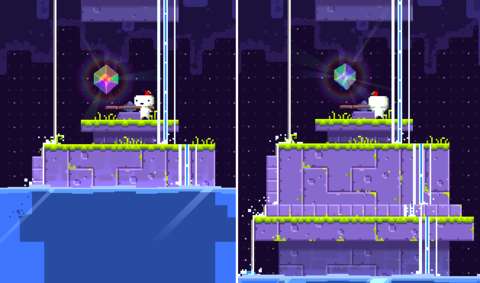
This can seem like a wasted opportunity to make use of the physical designs of water. To elaborate, the game could have made use of water-based puzzles, e.g. directional drains, instead of the ages-old puzzles of lowering water levels to access submerged areas.
With regard to platforming, water does break falls, but at best, this is only useful for saving time when moving downwards. Otherwise, falling into water is actually undesirable, because Fez would not die and respawn at where he was before he fell.
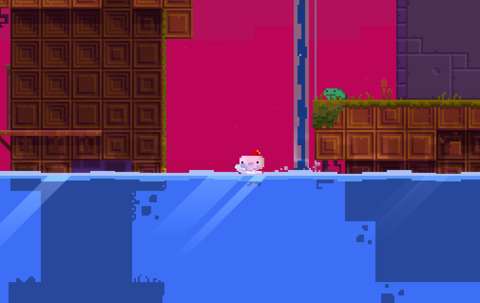
Water is not the only fluid in the game, but it is the only one which is innocuous. To elaborate this statement further would be to add another spoiler to this review though. Yet, it has to be said here that these other fluids are not any more sophisticated than water in terms of gameplay.
CLIMBING:
There may not be a lot of reasons for why Gomez is able to swim, but there are plenty for why he is good at climbing; his village simply lacks stairs and he has to get around by climbing things.
After the tops of crates, buildings and ledges, vines are the next climbable things to be introduced. Gomez can climb up and down, left and right and in diagonal directions when climbing vines. He can also hang onto vines, ledges and ladders indefinitely, conveniently enough.
It is also worth noting here that Gomez can also climb onto ladders and vines at the edges of building silhouettes. Gomez can use them to jump a bit further away, or use them for shortcuts up to the tops of buildings.
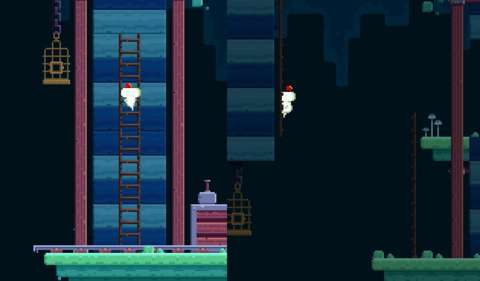
REGULAR PLATFORMING:
Although most of the gameplay experience in Fez involves the use of the world-rotating mechanism, there are still moments where the player has to resort to ages-old 2-D platforming.
Perhaps this would please players who want to have their nostalgia sated, but others would regard these moments as mere filler. There are also two zones in the game world with considerable regular platforming, and they can be very frustrating to deal with if the player does not resort to certain “New Game +” features. (There will be more elaboration on this later.)
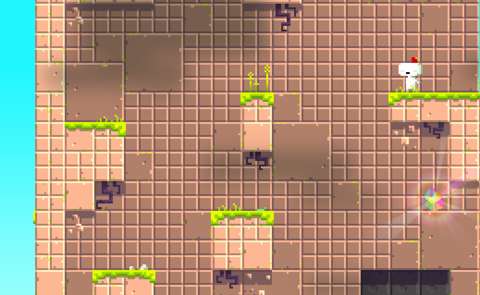
INVISIBLE PLATFORMS:
For better or worse, Fez does resort to ages-old tropes in the platforming genre, and not the entertaining ones.
Invisible platforms are examples of these. Of course, one could argue that veterans of platforming games would know that these are there, e.g. there is a visible platform which is seemingly out of reach but still within sight. Still, trying to gauge where to jump without knowing what to look for is not fun.
Fortunately, the player does have some chance of knowing that they are there (assuming that the player does not resort to guides outright). There are some in-game clues which point to their presence, such as treasure maps (which will be elaborated later) and the visual effects of some stages.
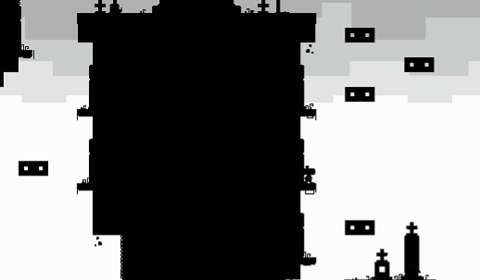
BOMBS:
Nintendo’s Legend of Zelda has influenced many games, and Fez would appear to be yet another game which would pay homage to it.
This homage takes the form of bombs which respawn continuously at certain spots; they are most common in the stages which resemble mines.
Gomez can pick up bombs and carry them around (in an adorable manner) before they detonate. His speed is not affected by much, but his jump height is. Keeping this limitation – and the world-rotating mechanism – in mind, the player can figure out the route to take before the bomb detonates.
Curiously, having a bomb detonate next to Gomez – or even right above his head – does not kill him. He gets a heck of a startle, but otherwise he is none the worse for wear.
When bombs detonate next to weakened structures (depicted by objects which have cracked textures, especially when next to sound structures), they cause the latter to collapse in a cascade of pixelated explosions.
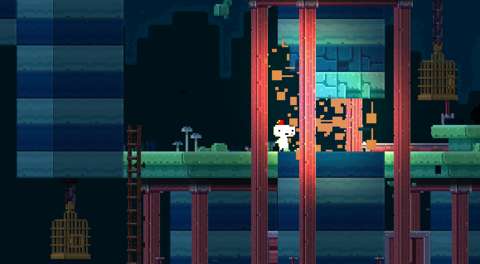
CRATES:
Bombs are not the only things which Gomez hauls around.
For better or worse, there are more mundane objects to pick up, namely crates. Like crates in other games – when they are not being broken to release goodies – the ones in Fez are only there to be either used as weights or as stepping stones.
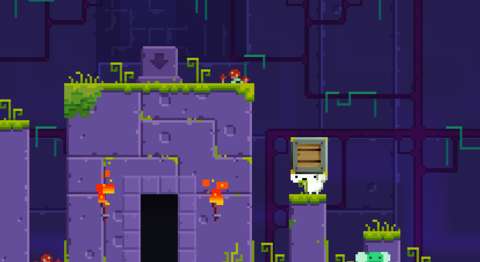
Speaking of stones, there are stones which are associated with some of the more intellectual puzzles in the game. These are a lot more interesting to work with, as will be described later.
MAP SYSTEM:
Node-based map systems have been used in some old-school games before, most notable of which is Legend of Zelda.
To elaborate, node-based maps usually represent levels as nodes in a network which in turn represents the game world. Although such a system shows which node is connected to which node, it is rather poor at showing the layout of the levels.
Fez’s system is no different in this regard, unfortunately.
Fez’s system tries to be different in other ways, but not necessarily for the better. It makes use of a three-dimensional presentation of the network, specifically an isometric view. The isometric view causes the icons for nodes to overlap in certain places of the network.
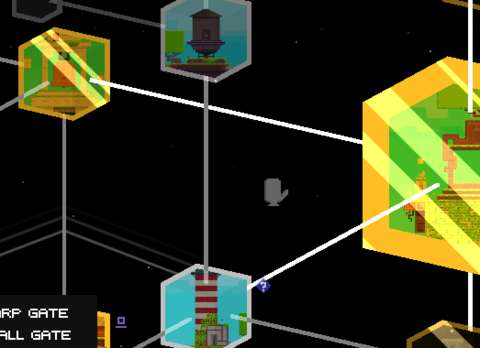
The presentation of the network of nodes could have been better if it was on a flattened 2-D plane instead.
At least Fez’s map system retains some of the advantages of the node network system, namely the easy-to-see display of the presence of secrets and collectibles in any level.
WARP GATE SYSTEM:
Fez’s game world is considerably large, and Gomez is a rather small person who has to get about on his own two tiny feet (at least until the second playthrough – more on these later).
Fortunately, Fez’s world has a system of warp gates which are centered on a hub in the aforementioned node network.
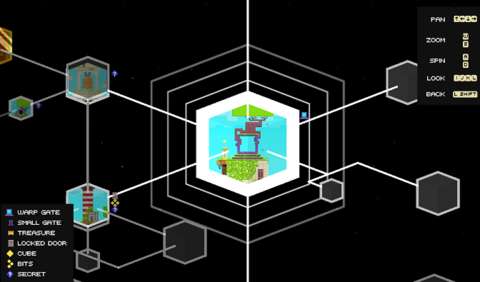
Each warp gate in each zone has four sides, each side leading to one of the four other zones in Fez’s world. The hub warp gate does have labels showing where each side leads, but these labels are in the game’s ‘Zu’ language (more on this later) and they do not actually describe zones well.
The best way to learn to use the warp gates is to associate each side of the warp gate with the sets of colors with are endemic in the zones. For example, the zones with mausoleums have primarily green skies with concentric squares.
There are also one-way gates to the nearest warp gate, usually the one in the same zone which the player is in. These one-way gates, which are noticeably different from the two-way ones, are usually located at dead-ends in the node network. Coincidentally, whole regular cubes are usually located over them when the player comes across them for the first time.
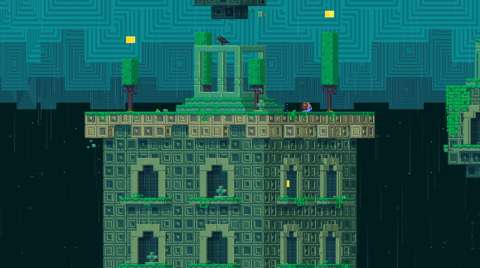
If there is a less-than-forgivable issue with the warp gates, it is their unpleasant sound effects. There will be more elaboration on these later.
DOLES OF SECRETS:
Fez’s world-rotating mechanism would have been seen as nothing more than a gimmick if not for puzzles and secrets which make use of it, usually in entertaining ways.
More importantly, very few of them are actually obtuse. For those which are not, there are in-game clues to investigate them with, and ultimately, solve them. Observant players who take notes (and screenshots) would be able to come up with the solutions when the game debuted the first time around on XBOX Live.
Of course, it has been a few years since the debut of the game, and most of the secrets are already out on the Internet. However, the logical processes with which the solutions are conceived are still within the game and can be appreciated by players who want to play the game without resorting to guides.
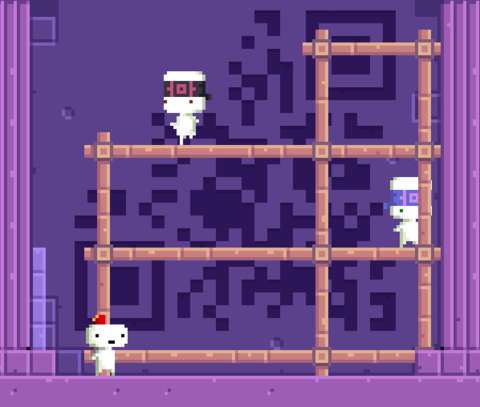
ANTI-CUBES:
As mentioned earlier, for every regular cube, there is a special (blue-colored) cube called an “Anti-Cube”. Anti-cubes are more difficult to find than regular cubes. They are usually the rewards for having discovered secrets or solving the more difficult puzzles, which will be described afterwards.
ZU LANGUAGE:
Many of the secrets in Fez can only be discovered by understanding a certain language which appears in the game.
This language, spoken by the ‘Zu’ people who appear some time into the playthrough, is practically the Latin alphabet applied with a substitution cipher. The language’s system for numbers is the real-world numeral system, albeit applied with a slightly more complicated cipher.
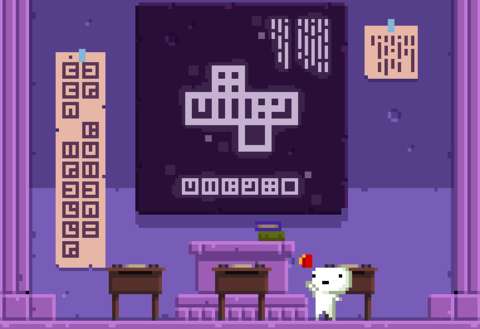
The game does have clues which help in figuring out the substitution cipher, but they can seem fourth-wall-breaking.
To elaborate, the player will need to have some knowledge, or memory, of children’s rhymes and limericks. Failing that, he/she has to have some knowledge of linguistics, i.e. be aware of what “pangrams” are. Otherwise, when the player comes across the most important clue for the cipher, he/she would merely see a bunch of sprites flitting around.
(Incidentally, the player will also come across the most easily obtained “artifact” in the game within the same area as the clue.)

SHAPE PUZZLES:
If Fez’s presentation does not make it clear enough already, Fez particularly features the cube in its gameplay. The cube also happens to be prominent in some puzzles which yield anti-cubes.
Like the cipher for the Zu language, the player may need either knowledge of children’s playtime activities, or knowledge of polygons and how their 2-D surfaces make up 3-D objects.
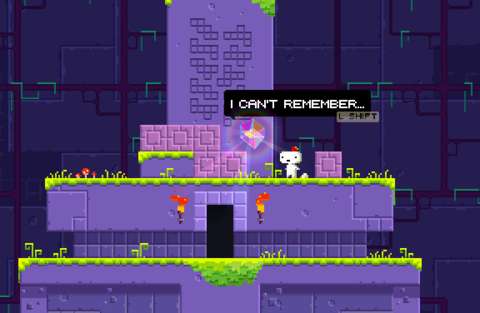
AUDIO/TACTILE PUZZLES:
It has to be said here that Fez cannot be criticized for having a lack of variety in its puzzle designs; this much should be evident when the player comes across the first puzzle which makes use of the player’s speaker system or the rumble-function of the Xbox 360 controller.
However, it would be naïve to think that players who are not expecting such puzzles would appreciate them just because they are surprised.
An example of these puzzles is the structures which resemble tuning forks. The forks emit directional sounds or induce directional vibration in an Xbox 360 controller; these are actually hints on what the player should do.
Players who, for whatever reason, are not using Xbox 360 controllers (e.g. die-hard computer users) or do not have a sound system with stereo might be stumped. Upon looking at a guide, they might not be pleased to realize that their ability to solve puzzles had been restricted by their use of limited hardware.
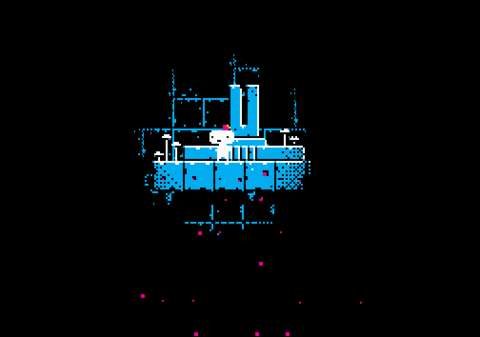
CONTROL-INPUT PUZZLES:
For better or worse, Fez pays homage to ‘cheat codes’ of yore too. To elaborate, the ‘cheat codes’ of old games in the waning years of the 20th. century were little more than sequences of control inputs which are made in main menu screens or some other places to trigger scripts which have been deliberately included in the games. In those games, these usually provide outrageous benefits such as invulnerability for the player character.
In Fez, the control-input strings are used to reveal secrets instead, usually anti-cubes which come out of nowhere.
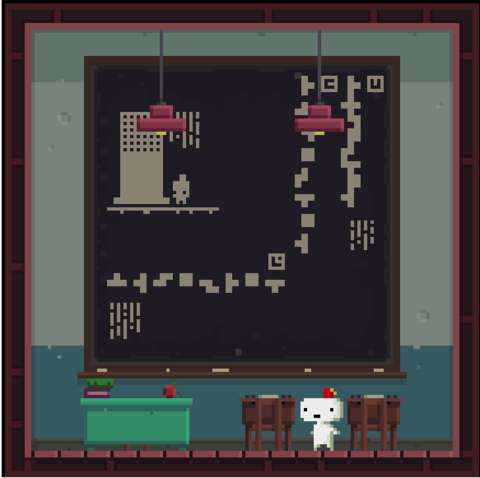
Although there is an in-game clue about such puzzles, and even a level dedicated to that clue, the Steam (and Xbox LIVE) version of the game has an achievement which already gives their presence away. Compared to the in-game clue, it is a far less elegant way of teaching the player about solutions to control-input puzzles.
Part and parcel of the solutions for control-input puzzles is a certain gameplay feature which would only be introduced in Fez’s “New Game +” mode, which will be described later. However, this also means that players who do not resort to guides are not likely to be able to completely finish the game the first time around.
TREASURE MAPS, KEYS & CHESTS:
As further homage to old-school games of exploration, there are treasure chests and golden keys.
Treasure chests, despite their appearance, are completely unlocked containers. However, the challenge posed by the chests lies in how to get to them. Some can be reached through determined platforming efforts, but the paths to others are not so obvious.
Incidentally, players who want to reach these more difficult-to-get chests will need to obtain “treasure maps”. These pieces of parchment do not exactly show the locations of treasure, but rather the way to get to them.
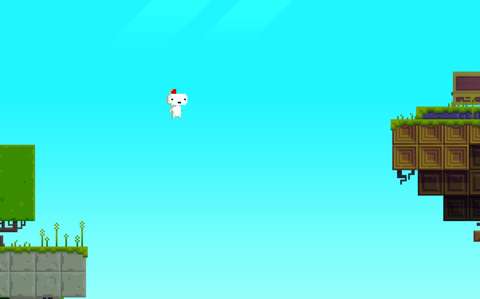
By examining the map system, the player can see which nodes have locked doors. These can only be opened with keys, which are usually found in treasure chests.
Perhaps not so coincidentally, nodes with locked doors usually have at least one adjacent node which has a treasure chest containing a key. This is convenient.
BLACK HOLES:
As the player progresses in his/her playthrough, he/she may notice that occasionally, ominous patches of static (or the void of space – it’s not clear) appear in the world. Dot claims that they appear more frequently as Gomez uses the Fez’s ability to rotate the world, but it is more likely than not that the probability of their appearance is completely random.
For each level, there are certain regions within it where patches of black holes (for lack of better words to describe them with) appear; they always appear at these regions if the scripts which spawn them happen to trigger.
Unfortunately, they often appear at places where they especially complicate the player’s efforts at platforming. An example is shown in the screenshot below.
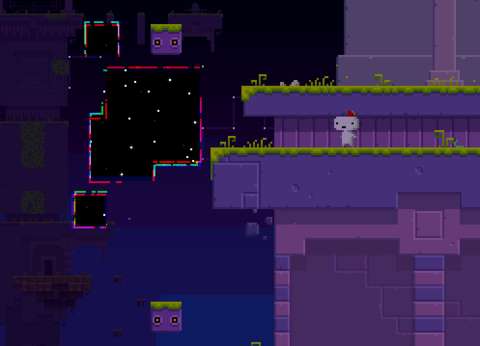
Observant players might notice that the black holes can be forced to de-spawn by leaving and entering the level repeatedly until they go away. This is not a guarantee of course, but getting the black holes out of the way is desirable. After all, there does not appear to be any tangible reward for putting up with them while platforming.
CUBE-UNLOCKED DOORS:
As the player progresses in the game, he/she would notice that there are doors which have to be unlocked by having a certain number of cubes in Gomez’s possession.
These act as progress milestones. The more cubes which a door demands, the closer the player is to completing the playthrough.
This would not have been worth mentioning, if one does not consider the fact that there does not appear to be any other indicator of the player’s progress. The cubes would also be merely collectible items if not for the gates.
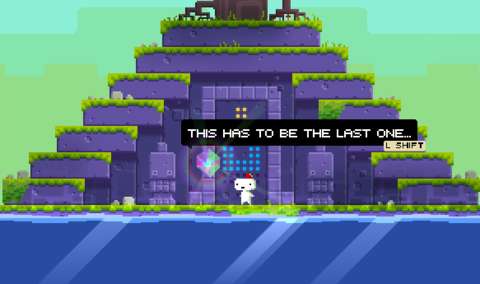
WORLD-ROTATING OBJECTS:
Gomez’s Fez is one of few objects which can rotate the world. However, there are other objects other than magical headwear which can rotate the world.
There are zones with machines which rotate the game world, usually automatically.
In a couple of these zones, these machines are actually more of a hindrance than a genuinely interesting component of gameplay, however. This is because the player has to time his/her own rotations to counteract those caused by machines. Otherwise, Gomez drops off the platform which he is supposed to land on.
Worst of all, the respawning mechanism does not consider these machines when deciding where to place Gomez when he respawns. More often than not, the game places Gomez before the start of a stretch of such platforms, thus forcing the player to re-attempt the entire stretch.
Such tedium is particularly frequent in the industrial- and academia-themed zones. Fortunately, there is an option to completely circumvent it, as will be described later.
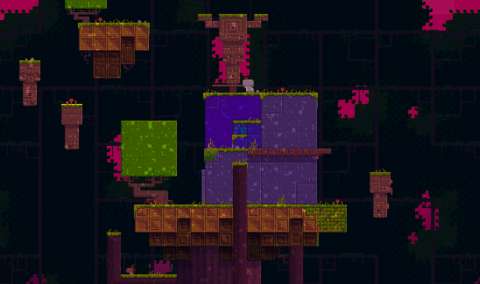
NEW GAME +:
After completing the first playthrough of Fez, the player can start a new playthrough using the “New Game +” rules – that is, assuming that the player is still intrigued enough to continue playing the game.
New Game + has Gomez already starting out with his headwear, but the headwear’s capabilities are only reactivated after he has met with the sentient MacGuffin in Fez. In addition, Gomez is granted an additional magical item, which gives the player a new camera option. New Game + also grants Gomez another ability, which is of far more.
In addition to these abilities (which will be described shortly), the player’s progress from the previous playthrough is also retained, e.g. the collectibles which have been retrieved remain in Gomez’s inventory.
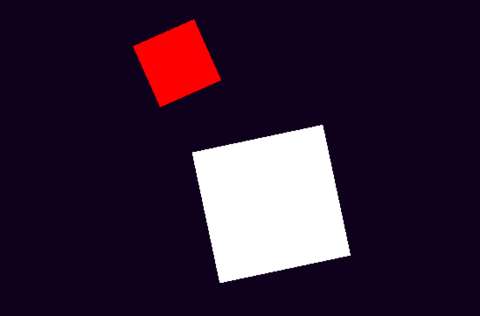
FIRST-PERSON CAMERA:
Players who had been wondering whether Fez’s game world is really 3-D or merely an illusion would know the answer upon activating the first-person perspective in “New Game +”. Unfortunately, the experience may be underwhelming.
Firstly, the observant player might notice that the first-person camera has an odd warping to it, as if the player is looking through a particularly curvaceous lens. This is much unlike first-person views in games which actively utilize first-person perspectives.
Looking around is not exactly easy either. The player uses the mouse of course, but must hold down the left mouse button to look around; this suggests that the set of controls for the first-person perspective is a near-straight hold-out from the console version of the game.
Moreover, it is not clear what rules the game uses when deciding what Gomez is looking at when the first-person mode is activated. The player may be given a view of something perpendicular to the screen or parallel to the screen with no discernible reason.
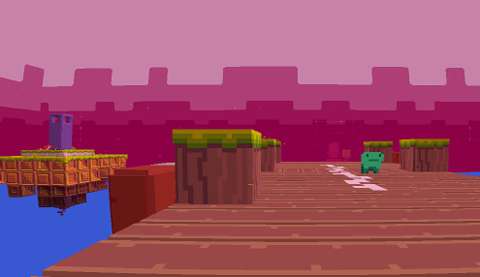
The most glaring issue about the first-person perspective is that the game freezes the animations of characters and loops their associated sound clips. As an example, in the previous screenshot, there is a green frog on-screen; its animation has been frozen. If it was frozen in the middle of its croaking animation, the player would be listening to its croaking until he/she disables the first-person mode.
FLIGHT:
Flight is granted onto Gomez in “New Game +”, but this is not told to the player in-game. Rather, this was mentioned by Polytron in its Twitter feed; it was supposedly included in order to make it easier for completionist players to obtain the remaining collectibles.
This convenience is certainly great, at least to players who have little patience for platforming gameplay. To other players though, this may seem to cheapen the experience. Although one could argue that using flight is optional, there is no significant reward for using the regular controls.
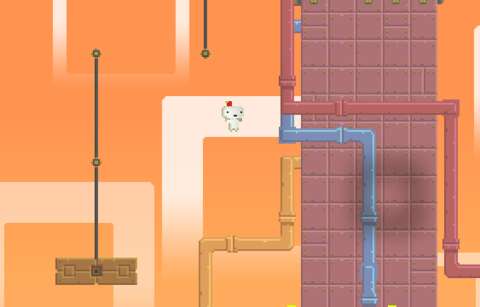
OBTUSE PUZZLE:
At this time of writing, there appears to be one puzzle with an obscure solution which has no confirmed in-game clue as to how to solve it.
The release date was purportedly the clue to the solution for this puzzle, but nothing in-game points to why it is so and how it is related to the purported other clues.
Considering that the other puzzles were designed with clearer clues, this one sticks out like a sore thumb and might sour the experience of the game for a player who had been expecting consistency in the puzzles.
WAITING PUZZLE:
For better or worse, there is a puzzle in the game which can only be solved by waiting, if the player wants to play the game as Polytron intended. Waiting around is hardly fun.
To give the puzzle some credit though, it makes use of one hand of a clock which moves a lot faster than the other three hands. This one would quickly indicate to any player who is observing the puzzle that it is one which is dependent on the system clock of the computer.
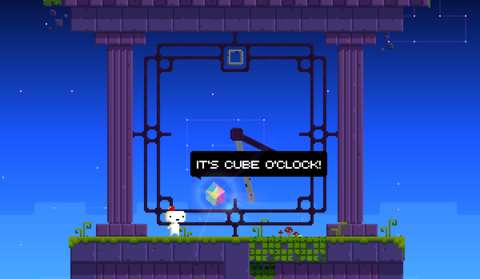
BEWILDERING REWARDS:
As mentioned in the subtitle of the user review, the player should not expect particularly satisfying rewards from completing the game.
After completing the first playthrough, the player is shown a cutscene of abstract shapes shifting around, which may be suggesting something about the backstory of Fez – or it may be just the side project of a Polytron member who happens to have a penchant for abstract art.
Then there is the Zu language. There is much text in the game which is written in the Zu language, but after the player has translated them, he/she would find that only some of it is relevant to the gameplay (i.e. it is part of puzzle solutions) or backstory.
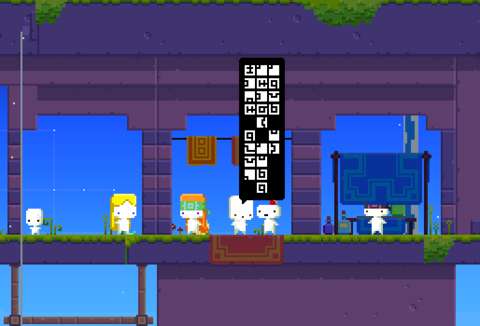
Even the statements of the character which is supposed to be the most relevant to the backstory amounts to nothing much in terms of narrative.
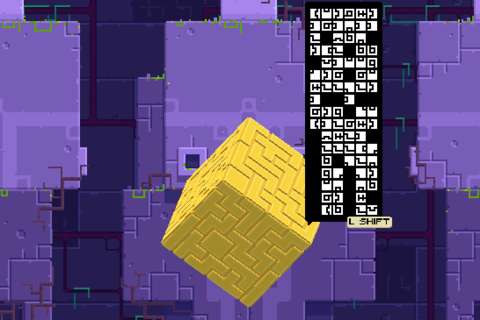
Then there is a trio of particularly difficult-to-get collectibles with very little significance to the story. There has not been exposition from Polytron either. Until now, they remain unanswered mysteries, which in turn leads to dissatisfaction when one looks at this game in hindsight.
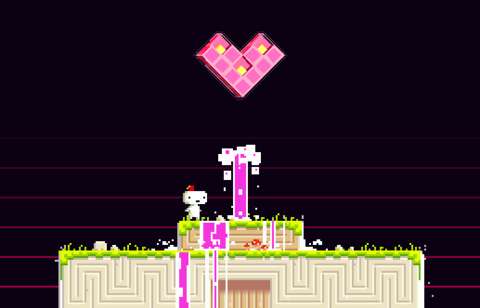
One could ascribe the saying that is “the journey is its own reward” to the experience in Fez, but not everyone would be so willing to give Fez the benefit of the doubt long after its hype has cooled down.
VISUAL DESIGNS – THE BETTER ONES:
Obviously, Fez makes use of old-school low-resolution graphics to give itself a nostalgic vibe.
In actuality, the game makes use of 2-D sprites which mingle about in 3-D environments. This is not unlike what has been seen in old-school first-person shooter games, such as those which used id Software’s id Tech 1 and 2 engines. Of course, this is not immediately clear from the start of the game, because of how the game projects the 3-D environments as 2-D planes.
However, what Fez lacks in graphical technology, it compensates in practicality.
To cite an elaborative example, each of the different zones in the game world makes use of a distinctive tile design and color set which makes it easily recognizable. That their skies also look different from each other also helps the player distinguish between them, especially when using the warp gates.
When Gomez is close to the entrance to another level, the game loads up the level and shows its main 2-D plane as an image in the background; the image is skillfully replaced with the actual 3-D models of the level when the player goes to it.
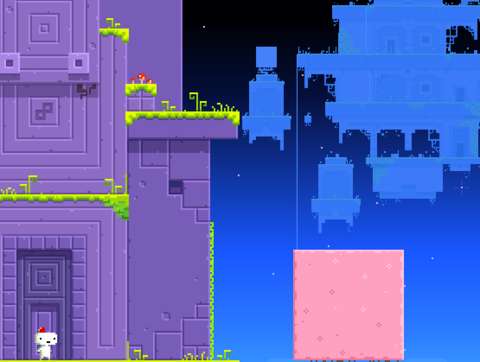
However, not all of Fez’s visual designs are splendid, as will be apparent shortly.
VISUAL OBSCURATION UPON WORLD ROTATION:
If the player rotates the world when Gomez is standing in front of an opaque wall, Gomez’s sprite is obscured. Gomez is still considered to be moving about in the 2-D plane which he was in before the player rotated the world, meaning that the player faces the risk of having Gomez run into hazards if he/she decides to continue moving Gomez about anyway.
This is not desirable, and something which the game does not appear to warn the player about. There is a noticeable subduing of the audio of the game, but otherwise the game lets the player find out the hard way about the risks of moving Gomez around while he is visually obscured.
LIGHT-SHOWS:
Fez may not be using state-of-the-art graphical technologies, but that did not stop Polytron from using its Trixel engine for some visual pizazz.
Most of said pizazz takes the form of light-shows, where something emits light or sparkly things appear on screen for no reason.
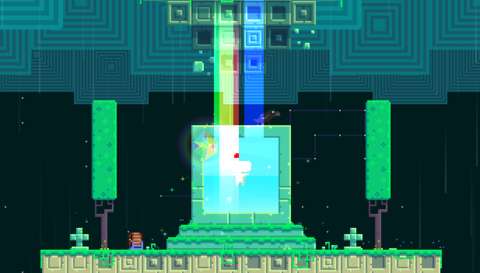
After a while, they may seem rather frivolous.
PURPOSELY GLITCHED GRAPHICS:
For no discernible reason other than a fashion statement, Fez makes use of deliberately glitch-ridden graphics. An example has been shown earlier in the very first screenshot; it will happen a few times again later in a playthrough.
Considering how unpleasant they are to look at, most of these are thankfully limited to in-game cutscenes.
It so happens that Fez, perhaps unapologetically, does not come with warnings for seizure-prone or epileptic people.
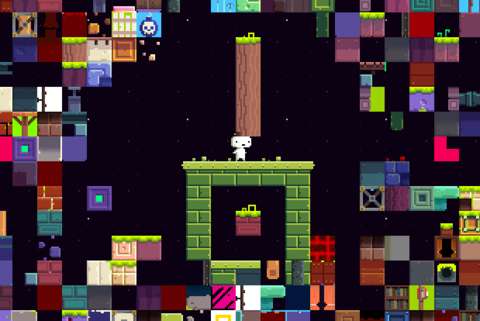
(MOSTLY AWFUL) SOUND EFFECTS:
Fez does have some good sound designs, but this would not be clear from the first impression which it makes. Rather, Fez has some awful ones too, and they so happen to be most of the sound effects in the game.
Its ‘Press Start to Play’ screen is the very first example, its subwoofer-wrecking reverb welcoming the player into the main menu.
What passes for the game’s ‘voice-overs’ are little more than clacks, warbles and such other noises which can be grating to listen to for more than several seconds. Fortunately, the player can rush the game’s dialogues quickly, which also silences the noises.
At least there are some sound effects that are welcome, such as the aforementioned chime which cube bits emit.
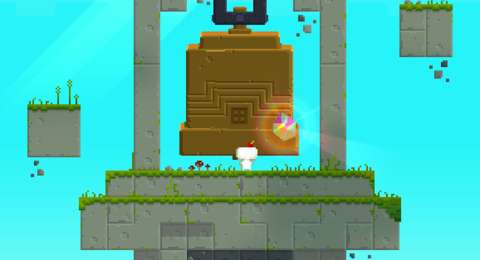
MUSIC:
The music of Fez is the best portion of its audio designs. Disasterpeace, a.k.a. Rich Vreeland, is the composer of its splendid electronic music. There are many tracks to listen to, and most of them can be heard for free at sites such as Bandcamp.
However, listening to them in-game is also rewarding too, because some of the levels have their own sound clips which contribute to the music (such as the one in the upcoming screenshot).
Most of the music tracks are there as ambience for the levels, such as the aptly-named “Fear” for the storm-wrecked mausoleum-themed levels.
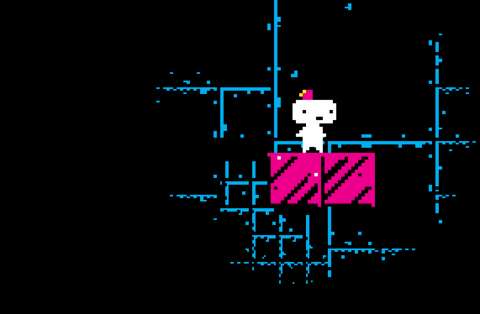
REMARKS ON BACKSTORY:
A game world would be little more than an excuse for a game’s gameplay without a narrative to support its existence.
Polytron has made a game world for Fez as well as the backstory for it, but the backstory is not exactly clear. To cut Fez some slack, it is not the only game which leaves a lot of questions about its backstory unanswered, if only to conjure speculation among fans as a way to hype up the game with.
Yet, whatever backstory that Fez has does not diminish the impression that its game world has been designed only to support its gameplay.
To cite an illustrative example, most of the levels which the player comes across appear to be ruins of a monarchic civilization of sorts with influence from aliens. That they are ruins gives a great excuse to have bits and pieces of masonry floating around to act as platforms. Yet, there is no explanation as to how these platforms can float when almost everything else is affected by gravity.
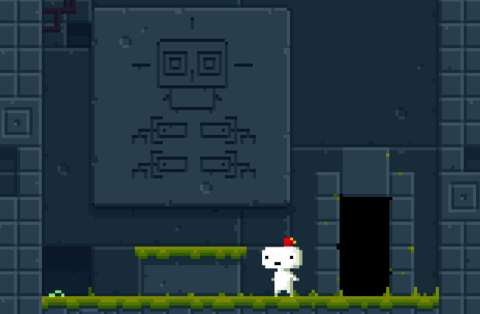
BUGS:
Although Polytron has been providing (infrequent) product support for this game since its release on the computer platform in 2012, the occasional bug still occurs. That most of the updates for the game have been optimization and patches instead of content additions can also seem disappointing to value-seeking game consumers.
The camera is usually reliable in showing a decent view of Gomez’s surroundings. However, whenever the game takes control of the camera to show something, such as the opening of a secret door, the camera may not return to its original position.
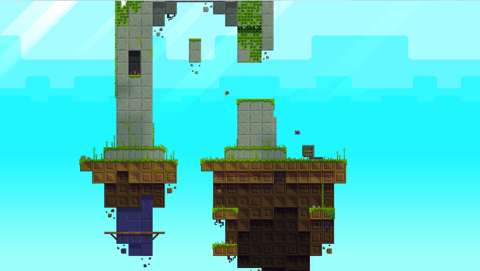
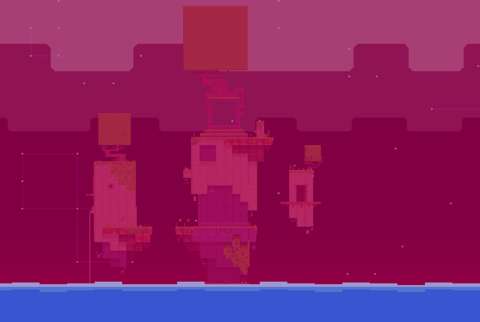
CONCLUSION:
Frankly, it has to be said here that Fez had a lot of hype, though much of is quite deserved. For its time, and even until now, it has something that few other games have: a perspective-shifting gameplay mechanism which makes use of orthogonal projections. Fez makes good use of its unique mechanism for its many puzzles too, even though the fundamentals of most of its puzzles have been done before.
However, Fez has issues which its strengths cannot overshadow. Chief of these is the lack of satisfying rewards for putting up with the game’s challenges. The porting of its original Xbox LIVE version over to the computer platform is also fraught with minor but many problems which arise from both lack of optimization and lack of experience with computer game controls on Polytron’s part.
All these setbacks serve to diminish the game’s achievements and appeals in hindsight, giving rise to the impression that Fez was little more than a runaway hit instead of a game-changer in the game industry.

Still, if one is looking for an entertaining one-off experience, Fez more than delivers.
